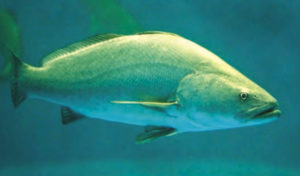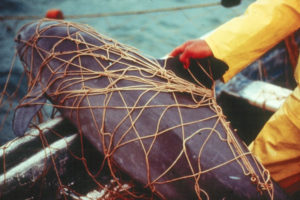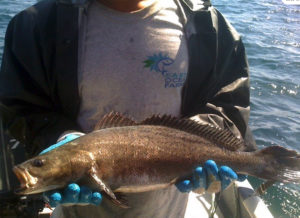Illegal fishing and China’s demand for maws have pushed one of Mexico’s signature fishes – and with it the vaquita porpoise – to the brink of extinction

In the sad tale of the vaquita and the totoaba – a Shakespearean saga if the oceans ever wrote one – a tragic ending for one of the main characters appears nigh.
The tenuous fates of these two marine species – the pint-sized porpoise and the slow-growing fish – have long been linked by geography, corruption and Traditional Chinese medicine. Both the vaquita and the totoaba, endemic to Mexico’s Sea of Cortez, are critically endangered. But only one of them has a realistic chance of returning to abundance, through aquaculture.
With only 30 of the world’s smallest marine mammals remaining in the Gulf of California, according to the latest estimates, even the most optimistic observers of its decline say the vulnerable vaquita (Phocoena sinus) may not make it to the end of 2017. The porpoise has been pushed to the brink of oblivion as bycatch in illegal fishing nets designed to catch totoaba, a cousin of the croaker species.
Both the vaquita (also known as the cochito and Gulf of California harbor porpoise) and the totoaba are afforded Appendix I protections by the Convention on International Trade in Endangered Species of Wild Fauna and Flora (CITES), and each is on the Red List of the International Union for Conservation of Nature and Natural Resources (IUCN).
Like rhinoceros horns and tiger pelts, trade in totoaba parts is illegal. But in China, where import regulations are lax or nonexistent, a hunger for them has existed for more than a century. A similar fish, the giant yellow croaker (Bahaba taipingensis), was fished to nearly the point of extinction in the south of China. Catches of giant yellow croaker nowadays merit newspaper articles, according to IUCN, which reports that the current totoaba population is unknown. In fact, no official totoaba population assessment has been conducted for more than 40 years.

The driver of the totoaba’s steady demise is a black market for maws – swim bladders, the internal gas-filled organs the species uses to regulate buoyancy in various depths of water. When dried, maws resemble translucent scraps of leather, and the bigger the better. “Gold coin” maw, as top-quality product is known, is an increasingly rare (if utterly devoid of flavor) delicacy that is typically served at celebratory feasts or imparted as a business gift or as a wedding dowry. Maws are perceived in Eastern medicine to impart vitality, aid kidney function and improve skin quality, among other benefits.
More recently, due to dwindling availability and sky-high prices, totoaba maws have become collectors’ items, speculative investments for wealthy, powerful people.
The totoaba (Totoaba macdonaldi) is a fish known to live for up to 30 years, grow to 2 meters in length and weigh up to 135 kilograms. Because with maws, size matters: According to the Elephant Action League (EAL), a nonprofit group dedicated to endangered wildlife that recently investigated the illegal trade of maws in China and shared its findings in the report “Operation Fake Gold,” the “big tube” totoaba maws from the largest fish fetch exorbitant prices, up to $20,000 per kilogram. In China, the product is known as jin quian min, or “money maw.” Other reports from Hong Kong markets put sales prices closer to $50,000 a kilo.
Efforts by the Mexican government to restrict the illegal use of totoaba gillnets, which have strangled hundreds of vaquitas, have been heavily and deservedly criticized. Despite banning commercial harvests since 1975, officials’ enforcement of both fishing and smuggling has been lax. Adding to the challenge: The trade of maws is tightly controlled by Mexico’s powerful drug cartels.
“They’re more valuable than cocaine,” Pablo Konietzko, general manager of Earth Ocean Farms in La Paz, Mexico, said of the maws.
Despite their best efforts, totoaba farmers like Earth Ocean Farms, unfortunately, are unlikely to save the vaquita. The totoaba, on the other hand, stands a fighting chance.
It’s a complicated and sad situation. A lot of people are trying to do the right thing.
Totoaba: farming and fishery enhancement
Because of CITES restrictions, totoaba can only be sold within the country, where Konietzko says local demand for the fillets is strong. But the fish being served in restaurants and hotels wasn’t caught in gillnets – they are born in hatcheries and raised in state-of-the-art farming equipment. Earth Ocean Farms, part of the Cuna del Mar portfolio, began farming totoaba in submersible open-ocean cages called Aquapods in 2013.
The company grows fish that are harvested at 2 to 4 kilograms each; according to Konietzko, it takes roughly two years to grow the fry (minimum of 10 grams) to a size of approximately 6 kilograms. The math is therefore simple: It’s next to impossible to flood the market with farmed totoaba maws to devalue illegal trade.

“We’re not in the farming business to produce the swim bladders,” said Konietzko, because only the very big fish, about 40 to 50 kilograms in size, he added, command top dollar. “It’s rare to catch the big ones, the very valuable ones. The smaller ones have no value.”
Instead of feeding the craze for bladders, Earth Ocean Farms is farming the fish for sale – and for prosperity. While producing and fish from egg to harvest, the company also participates in a budding restocking program in Mexico.
Aquaculture is “one of many solutions” to preserve the species, said Konietzko, admitting that the task is difficult but not impossible. Efforts already undertaken in Mexico have relied on Universidad Autonoma de Baja California (UABC) research that began some 20 years ago, as well as the existing body of work on two closely related species: the red drum (Sciaenops ocellatus) and the white sea bass (Atratoscion nobilis).
“A restocking program is sensible because hatchery-produced juveniles could mitigate the lack of natural recruitment due to overfishing, habitat degradation and direct removal of juveniles by shrimp trawlers,” said Konietzko, pointing to the success of similar programs for salmon in Alaska, red drum in Texas, turbot in Denmark and white sea bass in California. (For more information about totoaba farming and restocking efforts, download the December 2016 World Aquaculture article written by Lorenzo M. Juarez, Konietzko and Michael H. Schwarz here: Juarez WAM Dec. 2016).
Konietzko said farming totoaba for the marketplace and for fishery enhancement (restocking) may help the species survive, and he holds out hope that it will serve as a protection for the vaquita. There are three totoaba hatcheries in Mexico, he noted: Earth Ocean Farms, UABC and the Center for Reproduction of Marine Species of the State of Sonora (CREMES) in Bahia Kino. The effort’s success will depend on the ability of hatcheries to collaborate, to maintain genetic diversity, to prevent genetic contamination and to avoid genetic drift of wild populations.
Dr. Marco Linné Unzueta Bustamante, director general of the Instituto de Acuacultura del Estado de Sonora, told the Advocate that the institute has been producing totoaba for the past four years and, with the authorization of SEMARNAT, has released 200,000 offspring in the region of Isla Tiburón. The Mexican fishing authority (INAPESCA), however, only last year began studying the abundance and distribution of totoaba in the Gulf of California, he added, illustrating the sluggishness of the government’s response to the totoaba decline.
“I hope that soon we can begin the study of the releases,” he said. “An effort must be made to define the performance, at the wild level, of such releases.”
Nobody wants to see a species go extinct. We want to be part of the solution.
Vaquita: Too little too late?
Kim Thompson, the manager of the Seafood for the Future program at the Aquarium of the Pacific in Long Beach, Calif., leads outreach and education initiatives to promote healthy and responsible seafood choices. Seafood for the Future guides people to purchase fish from responsible aquaculture and U.S. fisheries, and works with harvesters to adopt fishing gear that doesn’t entangle vulnerable species as bycatch.
Visitors to the aquarium, she said, are often “shocked” to hear that only 30 vaquita porpoises remain – there were nearly 600 in the Upper Sea of Cortez just 20 years ago – and that illegal fishing is largely responsible.
“It’s a complicated and sad situation,” Thompson said. “A lot of people are trying to do the right thing – all have same end goal, which is to save vaquita and totoaba. But people are coming at this from different directions and sometimes contradict each other.”
A number of non-governmental organizations have urged a boycott on all Mexican shrimp – wild or farmed. The National Resources Defense Council, the Center for Biological Diversity and the Animal Welfare Institute, among others, claim that shrimp vessels still regularly violate no-fishing areas designed to protect the vaquita.
U.S. seafood industry lobby group the National Fisheries Institute has called the boycott “misguided,” saying its importer members support efforts to mitigate the impact of commercial fishing on the endangered species, including the use of trawls instead of gillnets. NFI has stated that shrimp fishermen have done all they can to prevent vaquita deaths, while the NGOs contend that even supposedly legal fisheries, like for the corvina, serve as cover illegal activity.
The situation came to a full boil at the end of May, when a host of environmental groups expressed anger and frustration at the Mexican government, which extended a temporary ban on gillnets (imposed in 2015) instead of implementing and – most importantly – enforcing a permanent ban. The World Wildlife Fund said the last vaquita could drown in an illegal gillnet “before the end of the year.”
What options remain for the vaquita, other than a $4 million rescue and temporary captivity effort that may prove futile? The species has never been successfully captured and transported. Lost in the furor over illegal fisheries and jaw-dropping maw prices is the fact that the decline of both the vaquita and the totoaba truly began in the 1930s. Construction of the Hoover Dam greatly diminished the flow of freshwater from the Colorado River into the Sea of Cortez. Perhaps the vaquita’s end was written then, as water temperatures and salinity, in the species’ singular habitat, both increased.
But there’s still hope for the totoaba, if farmers can build on their knowledge. If the hatcheries can rebuild local populations. If Mexican officials can build an effective management regime.
“Nobody wants to see a species go extinct. We want to be part of the solution,” said Konietzko.
Thompson agrees that aquaculture operations like Earth Ocean Farms could at least provide jobs and a “sustainable, alternative livelihood” for impacted communities in Mexico.
“What [aquaculture] could do, in the long term, if we could save the vaquita by other means, is help support a healthier ecosystem and reduce fishing’s impacts in the future,” she said. “I’m sure they could work on that, but it’s a process. It’ll take time. The vaquita doesn’t have time.”
Author
-

James Wright
Editorial Manager
Global Aquaculture Alliance
Portsmouth, NH, USA
Tagged With
Related Posts

Health & Welfare
Japanese eels: Progress in breeding and nutrition
The Japanese eel (Anguilla japonica) is cultured in ponds in Japan, China, the Republic of Korea and other countries. Ongoing research is addressing knowledge gaps in the domestication, controlled breeding and nutritional requirements of the species.

Innovation & Investment
Artemia, the ‘magic powder’ fueling a multi-billion-dollar industry
Artemia, microscopic brine shrimp used as feed in hatcheries, are the unsung heroes of aquaculture. Experts say artemia is still inspiring innovation more than 50 years after initial commercialization. These creatures are much more than Sea-Monkeys.

Aquafeeds
The pink powder that could revolutionize aquaculture
KnipBio, a Massachusetts-based biotechnology startup founded in 2013, is refining the manufacturing process for a promising aquaculture feed ingredient that may one day form the foundation of the food that farmed fish eat.

Health & Welfare
Stirling researcher preps eyestalk-ablation alternative trials
University of Stirling Ph.D. student Simão Zacarias, who is from is Beira, Mozambique, will soon travel to Isla del Tigre, Honduras, to document evidence showing the benefits of breeding shrimp without eyestalk ablation. His is a journey of hopeful discovery.

